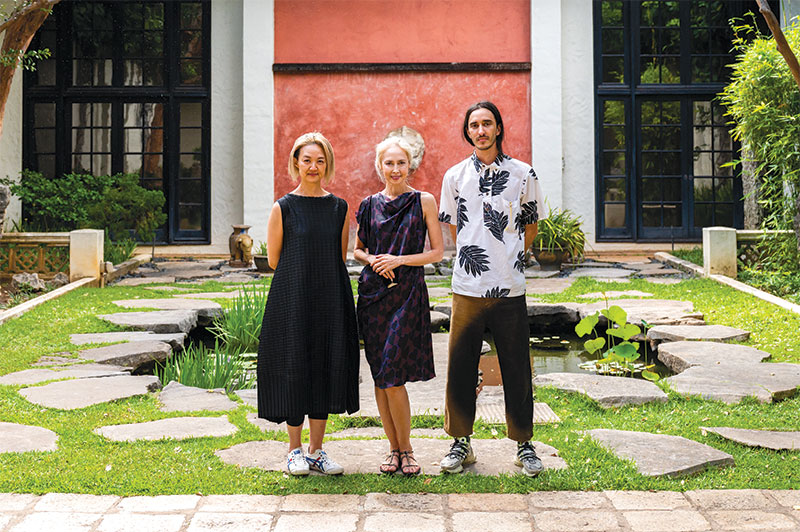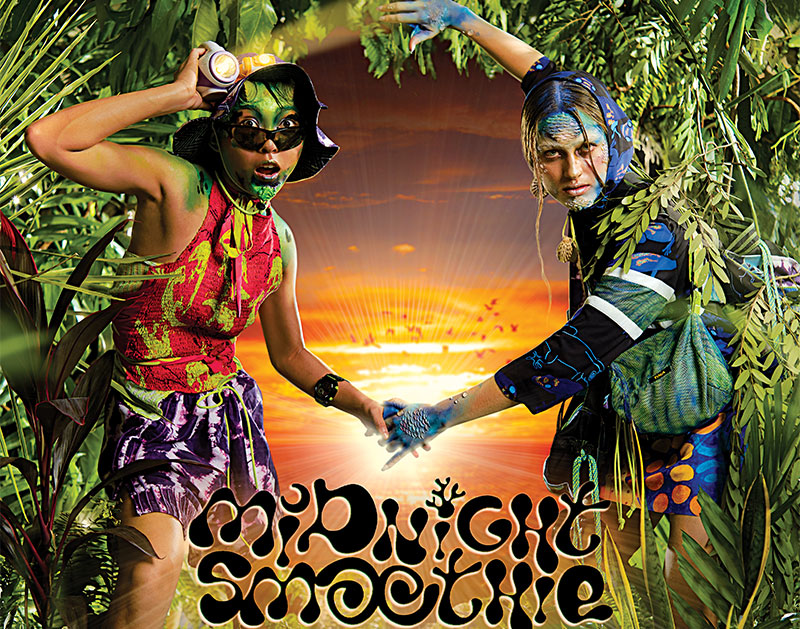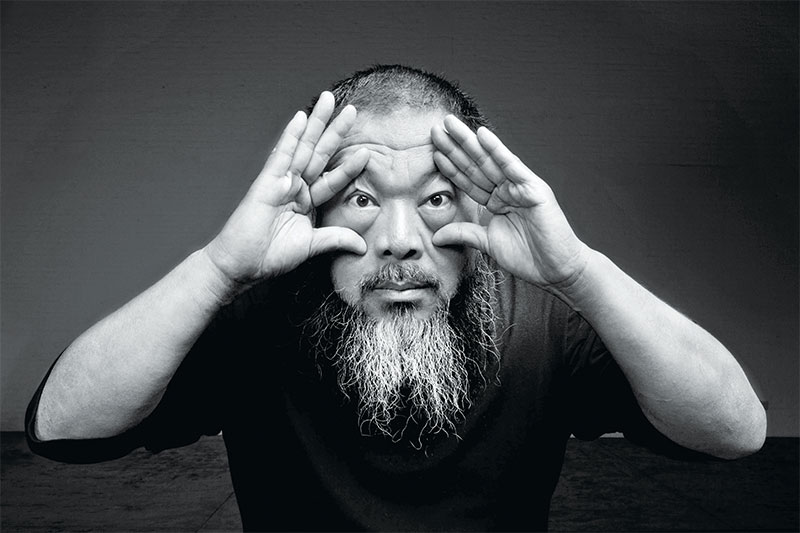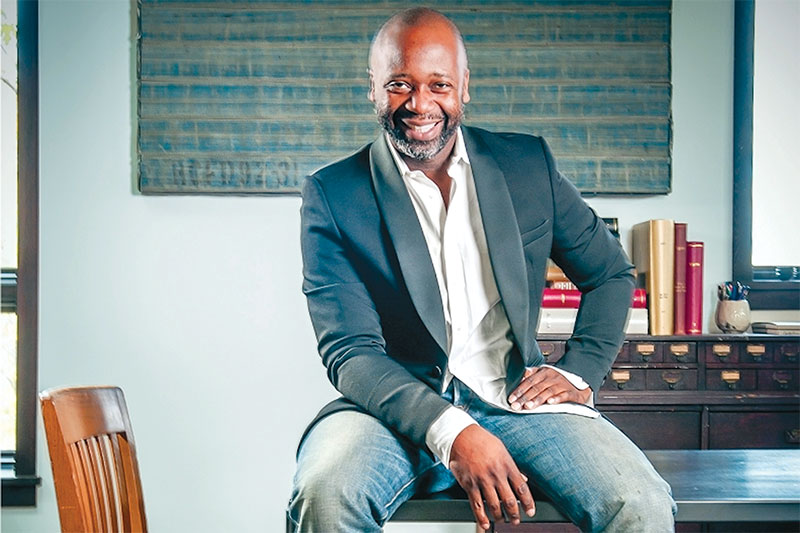Art And Soul

Dr. Melissa Chiu, curator for Hawai‘i Triennial 2022, is ~ anked by her associate curators, Dr. Miwako Tezuka and Drew Broderick, at Honolulu Museum of Art. PHOTO COURTESY HAWAI‘I CONTEMPORARY/BRANDYN LIU
Question: What do you get when scores of artists unite within a vibrant 21st-century arts ecosystem in Honolulu, and each anxious to share the fruits of his or her inspired labors with others?
Answer: The biggest, most-anticipated contemporary arts show ever grown and staged in the Pacific.
Say hello to Hawai‘i Triennial 2022, a citywide exhibition that throws back the curtains beginning this Friday, Feb. 18, before going on an 11-week run at venues around town. (See complete listing of sites on page 13.)
Previously known as Honolulu Biennial, HT22 is the event’s first attempt at operating under an every-three-years’ format. Like its previous iterations, this year’s showcase will feature the fruits, or artworks, of many talented homegrown and nonnative artists. This time, however, the focus is on interweaving themes of history, place and identity, as well as remedying cultural concerns while forging a way into what former U.S. Secretary of State Hillary Clinton once called “the Pacific Century.”

The film Midnight Smoothie from the collective TOQA will be shown at Foster Botanical Garden. PHOTO COURTESY HAWAI‘I CONTEMPORARY
“This show is really about asking the question: If it really is the Pacific Century, what does that look like?” says event curator Dr. Melissa Chiu, noting that Clinton first made the reference a decade ago during a speech at East-West Center.
HT22 is just one way of answering the question while also establishing Hawai‘i’s soul-defining role as that all-important “central, cultural place,” she clarifies.
“For Hawai‘i, this is an opportunity, on one hand, to see an exhibition of international art,” explains Chiu. “On the other hand, the exhibition speaks to thinking about what Hawai‘i can offer the world that is unique.”
Part of HT22’s distinctiveness lies in its title, Pacific Century – E Ho‘omau no Maoanuiākea. The brainchild of Drew Broderick, one of Chiu’s two associate curators, the title carries multiple meanings and speaks to the overall message behind the event.
“First, it recognizes the location of the Hawaiian archipelago, midway between North America and Asia,” explains Broderick. “The (Pacific Century) idea prescribes a shift from trans-Atlantic or U.S.-European economic and cultural supremacy toward the growing significance of Asia.
“Second, it acknowledges kānaka ‘ōiwi language and cultural values through a call to action — a timely reminder to persevere and continue on, across time and space, in relation to the many archipelagic nations of Moananui,” he adds. “It is important to note that this is the
first time that ‘ōlelo Hawai‘i is included in the title of the periodic exhibition. This is significant as it reflects the moment we’re living through … and marks another step in the right direction for the organization, one guided by indigenous worldviews and committed to a more rooted future here in Hawai‘i.”
The exhibition opens on the grounds of ‘Iolani Palace and features an outdoor projection of digitally animated flowers crafted by Los Angeles-based artist Jennifer Steinkamp — a clear reminder of the legacy of Queen Lili‘uokalani and her garden, Uluhaimalama. Thereafter, sites around Honolulu will begin showcasing the works of more than 40 individual artists and collectives before the curtains finally close on the show May 8.
With artist-led workshops, panel discussions, walking tours and keiki activities also planned for the event, Chiu anticipates that the show’s expected tens of thousands of art fans — ranging from the casual to the hardcore — will discover all that’s inspiring and astounding about HT22.
“Even those who are frequent museum goers will find something surprising about the exhibition,” she promises.
Standing at the forefront of this year’s collection of artists is Ai Weiwei, an iconoclast whose poignant sculptures, installation pieces and photography have been the source of inspiration to many over the years. The Beijing-born artist’s willingness to contribute to the show — first, by designing limited-edition face masks that honor the islands’ natural environment and whose sales benefit event organizer Hawai‘i Contemporary (email aloha@hawaiicontemporary.org to order); and second, by presenting a new iteration of his sculpture, Tree, which reflects an urgent call to action against environmental disruption — was naturally welcomed by Chiu and her associate curators, who include Dr. Miwako Tezuka.
Weiwei’s artwork, which will be staged on the upper terrace of Foster Botanical Garden, marks his first-ever showing in the islands.
“He’s grafted pieces of wood together to create a series of three trees — two of them are wooden, and the other is made from iron,” explains Chiu, an internationally renowned curator and native of Australia who currently serves as director of Smithsonian’s Hirshhorn Museum and Sculpture Garden in Washington, D.C. “Those three trees have a dialogue with the other trees at the botanical garden, so they speak to one another as a group.”
While Weiwei’s artistic achievements are recognized around the globe, it was also his roles as activist and documentarian that made him a necessary part of the exhibition, Chiu says. Aside from being highly critical of the Chinese government’s stance on human rights issues, Weiwei has also been one of the most vocal commentators on deforestation and pollution. As a result, the dissident artist has produced his share of documentaries that mirror his political convictions — most notably, Coronation (2020), Human Flow (2017) and Ai Weiwei: Never Sorry (2012).
As Chiu notes, “We wanted to include his work not only because of his standing within the art world, but also because he’s become more and more engaged with environmental issues. He was in Brazil and witnessed the degradation of the Amazon, and that sparked a number of his works that were based on trees.”
Other participating artists whose works will be featured include Hawai‘i’s own Jamaica Osorio, Gaye Chan, the late Haunani-Kay Trask, Ed Greevy and the video production team Nā Maka O Ka ‘Āina. Australia’s Richard Bell and the Philippines’ Leeroy New are just two of the international artists on HT22’s schedule.
A well-regarded poet, Osorio is expected to create a new poem for the exhibition, according to Tezuka, while Chan “will be doing works across the city that will be a surprise.”
Trask, a longtime activist and sovereignty leader who passed away last summer, and Greevy, a photographer, published the book Kū‘ē: Thirty Years of Land Struggles in Hawai‘i in 2004 over “their shared concerns for justice,” says Broderick. Honolulu Museum of Art, he adds, will be the site to honor their work through “a selection of powerful moments” taken from their book.
“Trask and Greevy’s friendship and working relationship endure as a testament to the importance of mobilizing in solidarity to protect people and place, while acknowledging cultural differences,” he says.
Formed by storytellers and documentarians Joan Lander and Puhipau (Abraham Ahmad), Nā Maka O Ka ‘Āina “emerged from the social and environmental justice movements that spread across the Hawaiian archipelago during the 1970s and persist to this day,” explains Broderick.
He adds that the duo’s many films — which include A Nuclear Free and Independent Pacific (1983), Waimānalo Eviction (1985), Kaho‘olawe Aloha ‘Āina (1992) and Mauna Kea–Temple Under Siege (2005) — will be presented at Hawaii State Art Museum and feature previously unreleased archival footage.
“Together, Lander and Puhipau (have) documented and perpetuated Hawaiian culture, history, language, art, music, dance, environment, and the politics of independence and self-determination in Hawai‘i, Moananui and elsewhere,” notes Broderick, an independent curator and educator from Kailua who serves as director of Koa Gallery at Kapi‘olani Community College.
As for Bell, he’ll be presenting “Embassy,” which Tezuka describes as “a nod to the 1970s Aboriginal movement and fight for land rights in Australia.” Meanwhile, the Manila-based New is expected to unveil one installation — made out of plastic bottles and surfboards — that is site-specific to Foster Botanical Garden.
“We wanted to bring in artists who we could bring in works that are not just illustrative of certain narratives, but who are also able to weave in historical and contextual stories into their materialization of artwork,” says Tezuka, an author and trained art historian who was born in Kanagawa Prefecture, Japan, and currently works as associate director for Reversible Destiny Foundation, a progressive artist-architects-poets group in New York.
Beyond the impressive collection of artistic talent, HT22 represents a major triumph for art fans who’ve been waiting for something to celebrate since the pandemic began. It also is a fitting accomplishment for an equally talented curatorial team that has labored many days and nights to ensure that this event comes to fruition.
As Chiu says, “It’s no small feat that this is happening in the age of COVID. There have been many interruptions and starts and stops along the way, but we have persevered and we’re so excited about finally being able to present this exhibition.”
HT22 And 7 Venues
Scheduled for Feb. 18-May 8, Hawai‘i Triennial 2022 will showcase the works of a number of participating artists and collectives at the following seven sites around Honolulu:
Bishop Museum — Chitra Ganesh, Michael Joo with Alchemyverse (Yixuan Shao and Bicheng Liang), Karrabing Film Collective, Izumi Kato, Paci~ c Sisters, Ahilapalapa Rands, Lawrence Seward, Gaku Tsutaja
Foster Botanical Garden — Ai Weiwei, Leeroy New, TOQA (Isabel Sicat and Aiala Rickard)
Hawai‘i State Art Museum — ‘Ai Pōhaku Press (Maile Meyer and Barbara Pope), Richard Bell, ‘Elepaio Press (Richard and Mark Hamasaki), Nā Maka O Ka ‘Āina (Joan Lander and Puhipau), Jamaica Heolimeleikalani Osorio, Piliāmo‘o (Mark Hamasaki and Kapulani Landgraf), Lawrence Seward, Tropic Editions
‘Iolani Palace — Richard Bell, Jamaica Heolimeleikalani Osario and Jennifer Steinkamp
Honolulu Museum of Art — Theaster Gates, Ed Greevy and Haunani-Kay Trask, Masanori Handa, Ai Iwane, Yuree Kensaku, Sung Hwan Kim and David Michael DiGregorio, Liu Xiaodong, Dan Taulapapa McMullin, Shinro Ohtake, Lawrence Seward, Mika Tajima, Xu Bing, Chikako Yamashiro, 目 [mé]
Royal Hawaiian Center — Herman Pi‘ikea Clark, Tsuyoshi Hisakado, Miao Ying, Beatriz Santiago Munoz, Lawrence Seward, Double A Projects (Athena Robles and Anna Stein), Sun Xun, Momoyo Torimitsu, Justine Youssef, Zheng Bo
Hawai‘i Theatre Center — Ming Wong








